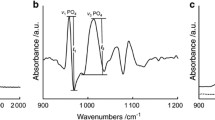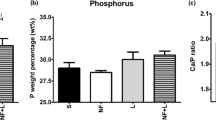Abstract
The present study aimed to evaluate the erosive potential of four most commonly prescribed syrup medicaments for respiratory diseases. Attenuated total reflectance-Fourier transform infrared (ATR-FTIR) spectroscopy combined with multivariate statistical analysis and micro-energy-dispersive X-ray fluorescence spectrometry (μ-EDXRF) mapping was performed. Fifty-five root dentin fragments obtained from the buccal surface of 30 bovine teeth were prepared and divided into five experimental groups (n = 10): control—artificial saliva (S), acebrofilin hydrochloride (AC), ambroxol hydrochloride (AM), bromhexine hydrochloride (BR), and salbutamol sulfate (SS). The S group was stored only in artificial saliva and the other groups were treated with the medicaments (immersed for 1 min in 3 mL of the medication, three times daily, with 1-h intervals between the immersion cycles, during 5 days, 15 immersion cycles). There were a significant decrease in the Ca and P weight percentages (wt%) for dentin after medication treatments, except for AC (p > 0.05). Mineral content of dentin showed a clear gradation with increasing Ca and P wt% reduction in the order S < AC < AM < BR < SS. SS resulted in a significant increase in Ca/P ratio when compared to the control (p < 0.001). ATR-FTIR combined with multivariate, statistical analysis can quickly and reliably indicate extent of dentin erosion. Considering syrups with high-erosive potential should always follow with proper oral hygiene practices or search for an alternative medications void of such detrimental effects. Regular and prolonged use of these medicaments might bear the risk of causing erosion.





Similar content being viewed by others
References
Spijker AVt, Rodriguez JM, Kreulen CM, Bronkhorst EM, Bartlett DW, Creugers NH (2009) Prevalence of tooth wear in adults. Int J Prosthodont 22(1):35–42
Phulari RG (2013) Textbook of dental anatomy, physiology and occlusion. Jaypee Brothers Medical Pub, India
Salas M, Nascimento G, Huysmans M, Demarco F (2015) Estimated prevalence of erosive tooth wear in permanent teeth of children and adolescents: an epidemiological systematic review and meta-regression analysis. J Dent 43(1):42–50
Bartlett DW (2005) The role of erosion in tooth wear: aetiology, prevention and management. Int Dent J 55(4):277–284
Tartari T, Bachmann L, Aga M, Andrade FB, Mah D, Bramante CM (2016) Tissue dissolution and modifications in dentin composition by different sodium hypochlorite concentrations. J Appl Oral Sci 24(3):291–298
Wang X, Mihailova B, Klocke A, Heidrich S, Bismayer U (2011) Effect of artificial saliva on the apatite structure of eroded enamel. Int J Spectrosc 2011:9. https://doi.org/10.1155/2011/236496
Zezell DM, Benetti C, Veloso MN, Castro PA, Ana PA (2015) FTIR spectroscopy revealing the effects of laser and ionizing radiation on biological hard tissues. J Braz Chem Soc 26(12):2571–2582
Kim I-H, Son JS, Min BK, Kim YK, Kim K-H, Kwon T-Y (2016) A simple, sensitive and non-destructive technique for characterizing bovine dental enamel erosion: attenuated total reflection Fourier transform infrared spectroscopy. Int J Oral Sci 8(1):54–60
Mehta SB, Banerji S, Millar BJ, Suarez-Feito J-M (2012) Current concepts on the management of tooth wear: part 1. Assessment, treatment planning and strategies for the prevention and the passive management of tooth wear. Br Dent J 212(1):17–27
Chellaih P, Sivadas G, Chintu S, Vedam VV, Arunachalam R, Sarsu M (2016) Effect of anti-asthmatic drugs on dental health: a comparative study. J Pharm Bioallied Sci 8(Suppl 1):S77
Scatena C, Galafassi D, Gomes-Silva JM, Borsatto MC, Serra MC (2014) In vitro erosive effect of pediatric medicines on deciduous tooth enamel. Braz Dent J 25(1):22–27
Soares D, Valinoti A, Pierro V, Antonio A, Maia L (2012) Cross-sectional microhardness of bovine enamel subjected to three paediatric liquid oral medicines: an in vitro study. Eur Arch Paediatr Dent 13(5):261–266
수경천, 문진정, 용순안, 예진이, 미경고, 순정정, 도선임 (2016) Effects of the enamel erosion caused by certain antipyretic and analgesic medicines for children. J Dent Hyg Sci 16 (3):235–241
Mazzoleni S, Stellini E, Cavaleri E, Angelova Volponi A, Ferro R, Fochesato Colombani S (2008) Dental caries in children with asthma undergoing treatment with short-acting ß2-agonists. Eur J Paediatr Dent 9(3):132–138
Soares LES, do Espirito Santo AM, Brugnera A, FAA Z, Martin AA (2009) Effects of Er: YAG laser irradiation and manipulation treatments on dentin components, part 2: energy-dispersive X-ray fluorescence spectrometry study. J Biomed Opt 14(2):024002–024007
Soares LE, do Espirito Santo AM, Junior AB, Zanin FA, da Silva Carvalho C, de Oliveira R, Martin AA (2009) Effects of Er:YAG laser irradiation and manipulation treatments on dentin components, part 1: Fourier transform-Raman study. J Biomed Opt 14(2):024001. https://doi.org/10.1117/1.3103285
Nahorny S, Zanin H, Christino VA, Marciano FR, Lobo AO, Soares LES (2017) Multi-walled carbon nanotubes/graphene oxide hybrid and nanohydroxyapatite composite: a novel coating to prevent dentin erosion. Mater Sci Eng C 79:199–208
De Carvalho Filho ACB, Sanches RP, Martin AA, do Espirito Santo AM, LES S (2011) Energy dispersive X-ray spectrometry study of the protective effects of fluoride varnish and gel on enamel erosion. Microsc Res Tech 74(9):839–844
Soares LES, De Carvalho Filho ACB (2015) Protective effect of fluoride varnish and fluoride gel on enamel erosion: roughness, SEM-EDS, and μ-EDXRF studies. Microsc Res Tech 78(3):240–248
Maguire A, Baqir W, Nunn JH (2007) Are sugars-free medicines more erosive than sugars-containing medicines? An in vitro study of paediatric medicines with prolonged oral clearance used regularly and long-term by children. Int J Paediatr Dent 17(4):231–238
Lussi A, Jäggi T (2008) Erosion—diagnosis and risk factors. Clin Oral Investig 12(1):5–13
Serra MC, Messias DCF, Turssi CP (2009) Control of erosive tooth wear: possibilities and rationale. Brazilian oral research 23:49–55
Malkoc MA, Taşdemir ST, Ozturk AN, Ozturk B, Berk G (2011) Effects of laser and acid etching and air abrasion on mineral content of dentin. Lasers Med Sci 26(1):21–27
Wang X, Mihailova B, Klocke A, Fittschen UE, Heidrich S, Hill M, Stosch R, Güttler B, Broekaert JA, Bismayer U (2009) Side effects of a non-peroxide-based home bleaching agent on dental enamel. J Biomed Mater Res A 88(1):195–204
Zero DT, Lussi A (2005) Erosion—chemical and biological factors of importance to the dental practitioner. Int Dent J 55(S4):285–290
de Moraes MCD, Freitas AZ, Aranha ACC (2017) Progression of erosive lesions after Nd: YAG laser and fluoride using optical coherence tomography. Lasers Med Sci 32(1):1–8
Featherstone JD, Lussi A (2006) Understanding the chemistry of dental erosion. Monogr Oral Sci. 20:66–76
Rufino JL, Santos JM, Rodrigues MA, Pezza HR, Pezza L (2009) Determination of ambroxol in syrups using diffuse reflectance spectroscopy. Química Nova 32(6):1513–1516
TdS DP, NUL T, Bertoldi AD, Farias MR, PSD A, Ramos LR, Oliveira MA, Luiza VL, Mengue SS (2016) Uso de medicamentos e outros produtos com finalidade terapêutica entre crianças no Brasil. Rev Saude Publica 50(2):1s–13s
Mackanos MA, Contag CH (2010) Fiber-optic probes enable cancer detection with FTIR spectroscopy. Trends Biotechnol 28(6):317–323
Van Nortwick M, Hargrove J, Wolters R, Crawford JM, Arroyo M, Mackanos M, Contag CH, Wang TD (2009) Fiber optic FTIR instrument for in vivo detection of colonic neoplasia–Endoscopic Microscopy IV. Proc. SPIE Vol.7172; 71728-1–71728-9
Bindig U, Müller G (2005) Fibre-optic laser-assisted infrared tumour diagnostics (FLAIR). J Phys D Appl Phys 38(15):2716
Acknowledgements
We would like to thank the São Paulo Research Foundation (Fundação de Amparo à Pesquisa do Estado de São Paulo, FAPESP) for the X-ray microfluorescence equipment (Grant no. 2005/50811-9).
Funding
We would like to thank the São Paulo Research Foundation (Fundação de Amparo à Pesquisa do Estado de São Paulo, FAPESP) for the X-ray microfluorescence equipment (Grant no. 2005/50811-9) and for Luis Felipe C. S. Carvalho scholarship (Grant no. 2014/05978-1). We would like to thank CAPES (Coordenação de Aperfeiçoamento de Pessoal de Nível Superior) for Tanmoy Bhattacharjee and Raimundo Nonato Silva Gomes scholarship (Grant no. 1649372).
Author information
Authors and Affiliations
Corresponding author
Ethics declarations
Conflicts of interest
The authors declare that they have no conflict of interest.
Ethical approval
The ethics committee for the use of animals in research of the University of Paraíba Valley approved this study (CEUA protocol n° A12/CEUA/2015). We declare that all researchers directly involved in animal experimentation followed the ethical principles in animal experimentation.
Informed consent
The research does not involved human participants, and there is no informed consent.
Rights and permissions
About this article
Cite this article
Gomes, R.N.S., Bhattacharjee, T.T., Carvalho, L.F.C.S. et al. Fast monitoring of tooth erosion caused by medicaments used in the treatment of respiratory diseases by ATR-FTIR and μ-EDXRF analysis. Lasers Med Sci 32, 2063–2072 (2017). https://doi.org/10.1007/s10103-017-2328-1
Received:
Accepted:
Published:
Issue Date:
DOI: https://doi.org/10.1007/s10103-017-2328-1




